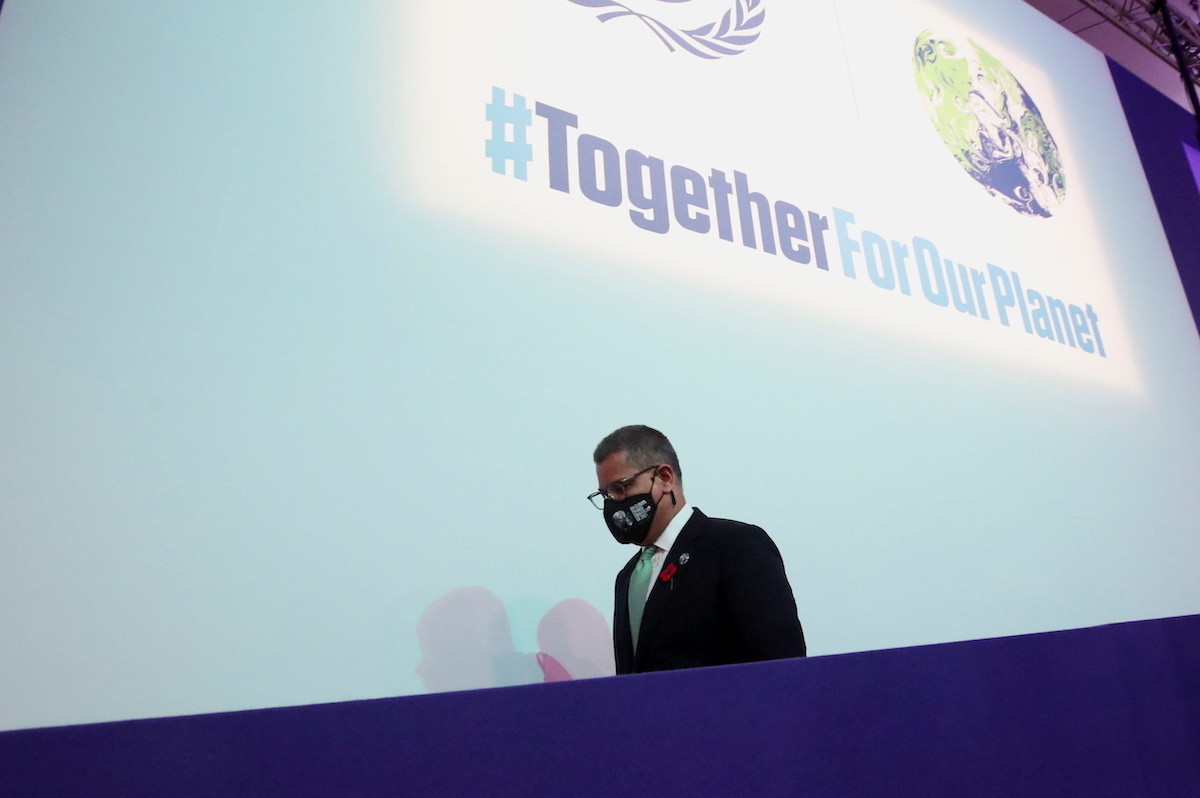13 Dec 2021
- No longer the ‘forgotten solution’, nature appeared prominently in the final text of the Glasgow Climate Pact, the agreement reached at the 2021 United Nations Climate Change Conference.
- We need to treat the food and land use transition with the same degree of urgency as the energy and industry transitions.
- The food agenda will likely feature more prominently at COP27 in Egypt and provides another opportunity to build momentum.
There has been no shortage of commentary and reflections on COP26, particularly on the role of certain governments and individuals. From my vantage point – as a Friend of COP and someone who has been involved in the forests and land use work for over a decade – the UK COP Presidency deserves credit for bringing the nature agenda into the heart of the climate negotiations.
No longer the ‘forgotten solution’, nature appeared prominently in the final text of the Glasgow Climate Pact. Perhaps most significantly, there was a full half-day of announcements and commitments made on Forests and Land Use during the World Leaders Summit on 2 November – 141 countries committing to conserve and restore forests by 2030, with more than $20 billion of public and private investment announced.
But while there was genuine movement and progress in Glasgow, we are clearly falling well short of what is needed collectively to limit temperature rises to 1.5 degrees Celsius; and there is scepticism that commitments will be honoured. Hence the tangible anger from youth and other communities that we witnessed on the streets of Glasgow – and all over the world.
For the nature agenda, what is now obvious is that we need to treat the food and land use transition with the same degree of urgency as the energy and industry transitions. It is very simple: the food system represents over a third of emissions; there is no path to 1.5 degrees without changing how we produce food and manage our landscapes. The food agenda will likely feature more prominently at COP27 in Egypt and provides another opportunity to build momentum on what we saw in Glasgow. They are two sides of the same coin: the health of our environment underpins global food security.
The real test for all of these issues – if we are to deliver on the decades of work in this sector from so many thousands of people – is not more words but turning commitments into action. There have been similar moments before, such as the New York Declaration on Forests in 2014 or the Consumer Goods Forum commitment in 2010. But there are five substantive reasons – particularly with the levels of public and private sector mobilisation – to be more confident this time round.
1. Government dialogue: While it may not have come with an eye-catching investment figure, the FACT Dialogue has brought together the 28 key countries that either produce or import ‘forest risk commodities’ such as palm oil, soy, beef or cocoa. The fact that governments, north and south, are talking to each other on key underlying issues relating to trade, transparency, smallholder finance and research and innovation provides a much stronger signal of the substance behind the Glasgow Leaders’ Declaration on Forests. Progress will only occur when countries in the ‘global south’ are able to pursue economic development and food production at the same time as better protecting their forests.
2. Credible corporate action: Many leading companies are now making tangible progress on eliminating deforestation from their own supply chains. They are grappling with the complexities on the ground: for example, in attempting to solve an environmental issue, they can create unintended impacts on livelihoods by excluding smallholder farmers. This requires finding creative ways to manage these trade-offs while strengthening climate action plans.
Examples of progress made at COP26 include an ambitious strategy for driving transformational change announced by the Forest Positive Coalition of Action of the Consumer Goods Forum. This will see all coalition members investing annually into programmes driving forest positive outcomes in commodity-producing landscapes, with the broader ambition to conserve and restore landscapes the equivalent size of their production-base footprint by 2030.
Another announcement – by 12 of the largest agri-commodity traders including Cargill, Wilmar and JBS – to work collectively to develop a roadmap to 1.5 degrees is also welcome. With regulatory, financial, civil society and consumer pressure all ramping up, the sector is coming together to address these issues – and is poised to make tangible progress ahead of COP27. The UN’s official campaign to mobilise non-state actors, Race to Zero, also now has more than 8,000 pledges with leading supply chain companies like Mars, Nestlé, Unilever and McDonalds joining ahead of Glasgow; many more will need to follow suit
3. Financial sector engagement: Until Glasgow, there had been very limited engagement from the financial sector in the matter of forests and land use. The fact that more than 30 leading financial institutions – with US$8.7 trillion of assets under management – committed to remove commodity-driven deforestation from their portfolios by 2025 is truly significant. However, it was notable that the banking sector was largely absent from such discussions in Glasgow (with the exception of Grupo Bancolombia), which is why the Tropical Forest Alliance (TFA) is convening a high-ambition banking working group in 2022.
These leading financial institutions will need to track progress over time and be transparent about the challenges in meeting these commitments. In parallel, we need to encourage many more of them to include deforestation and land use change in their roadmaps: while US$8.7 trillion is no small sum, the Glasgow Financial Alliance for Net Zero (GFANZ) saw asset managers, asset owners, insurance underwriters and banks with US$130 trillion under management committing to net zero.
4. Mobilisation of new finance: $US20 billion of public and private finance was pledged towards forest and land use during Glasgow. This is a great start but still a drop in the ocean compared to the hundreds of billions of dollars required. Four things provide some indication of changes coming:
- a) There is growing recognition that like fossil fuel subsidies, agricultural subsidies and policies will need to change if we are to make the changes required. At COP, 26 countries announced a range of reforms along these lines.
- b) Multilateral development banks announced their commitment to mainstreaming nature in their investments and policy dialogues with countries, which will help move capital flows toward the food and land use transition.
- c) Voluntary carbon markets are growing rapidly with investment expected to exceed US$1 billion in 2021. At COP, the LEAF Public-Private Partnership announced more than US$1 billion in commitments. But the finalisation of the Paris Rulebook and agreed text on Article 6 provides the guidance on how a regulated global market for carbon can now emerge, paving the way to unlock hundreds of billions in the coming year. Many detractors claim that carbon markets have never – and will never – work for forest protection or local communities, but in truth, we have never mobilised and deployed sufficient funds to make them work. Now we have an opportunity to get that right.
- d) One more promising signal comes from new finance mechanisms, such as the Innovative Finance for the Amazon, Cerrado and Chaco (IFACC) initiative where $3 billion of investment by 2025 has been committed by eight financial and agri-business companies to support farmers and landowners transition to more sustainable business models.
5. Transparent annual reporting and accountability: Finally, what is critical for both public and private commitments this time is that we monitor and report progress over time. One promising aspect of the Glasgow Climate Pact is the annual ratchet mechanism. Countries now have to come back to highlight progress and indicate how and where they are strengthening their nationally-determined contributions (NDCs) annually. We need a similar mechanism for all private-sector commitments. The CGF’s Forest Positive Coalition of Action published its first Annual Report in September this year with clear KPIs to track progress to combat deforestation. For corporate action to have credibility, including the roadmap the traders have committed to delivering, it must come with transparent reporting on progress, against targets rooted in science. Transparency of progress and accountability for actions must sit at the heart of the agenda for the decade ahead.
Many people have said that COP26 was ‘Nature’s COP’ – and there are many reasons to celebrate the collective action that led to the announcements. Indonesia has a term, gotong royong, which translates roughly into English as ‘communal work’. But in the Bahasa language, it comes laden with a collective responsibility and a sense of joy and fulfillment that comes from working together. This is what is now required – a deep commitment to collective action in service of the greatest need humanity has ever faced: to be the first global generation to reverse the damage we’ve created and restore our planet to health.
By Justin Adams
Original link: https://www.weforum.org/agenda/2021/12/five-reasons-why-cop26-should-finally-mark-a-turning-point-for-forests-food-and-climate/



